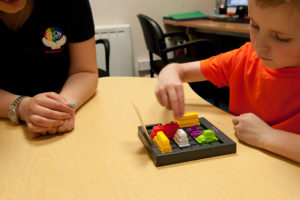Crossing the Body’s Midline
What does crossing the body’s midline mean?
The body’s midline is an imaginary line down the centre of the body that divides the body into left and right. Crossing the body’s midline is the ability to reach across the middle of the body with the arms and legs. This allows children to cross over their body to perform a task on the opposite side of their body.
Why is crossing the body’s midline important?
Crossing the body’s midline is an important developmental skill needed for many everyday tasks such as writing, reaching towards your foot to put your shoes and socks on with both hands and being able to complete puzzles when the puzzle is placed on the other side of the body. When a child spontaneously crosses the mid-line with the dominant hand, then the dominant hand gets the practice needed to develop good fine motor skills by repeated consistent hand dominance. If a child avoids crossing the mid-line, then both hands tend to get equal practice at developing skills and the child’s true handedness may be delayed. This means that once a child starts school, learning to write is much more difficult when they have two less skilled hands rather than one stronger, more skilled (dominant) hand. Difficulty crossing the mid-line also makes it difficult to visually track a moving object from one side to the other or track from left to right when reading, meaning reading can also be delayed.
How can I tell if my child is having difficulty crossing the midline?
If a child has difficulties crossing the body’s midline they might:
- Swap hands mid-way through a task such as when writing, drawing, painting or colouring
- Use their left hand for activities on the left side of the body and their right hand for activities on the right hand side.
- Rotate their trunk to the opposite side when reaching across the body to avoid crossing the midline.
- Have difficulty visually tracking an object from one side of the body to the other, such as following text when reading.
- Have poor handwriting skills
- Use different feet to kick a ball (mixed feet dominance)
- Have difficulty co-ordinating gross motor patterns (crawling, skipping, jumping jacks)
What can be done to improve the body’s ability to cross the midline?
- Encourage them to practice activities that build bilateral integration skills ( using both sides on the body together).
- Jumping and skipping
- Riding a bike
- Catching a ball
- Beating a drum
- Doing buttons
- Tying Laces
- Threading Beads
- Cutting with a Scissors
- Build midline crossing into everyday activities e.g. set up socks so they are placed on the other side of the child’s body so they are forced to cross the midline when dressing.
- Work on core stability and trunk rotation to encourage the physical movement of crossing the body’s midline.
- Popping bubbles with only one hand ( reaching across their body to pop the bubble on the other side).
- Try playing Simon Says and building in midline crossing opportunities e.g. rub your left elbow with your right hand.
If you have concerns about your child’s ability to cross their midline, an occupational therapist can support them to develop this skill.
References:
Crossing the Body’s Midline. (n.d.). Retrieved March 02, 2018, from https://childdevelopment.com.au/areas-of-concern/fine-motor-skills/crossing-the-bodys-midline/
Written By
Rebecca Duff, Occupational Therapist at Sensational Kids
Copyright
Sensational Kids CLG 2018


